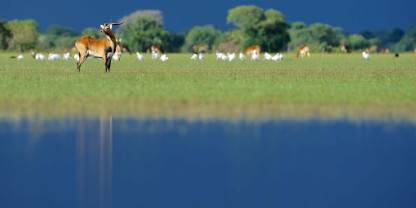Average Expert Rating
Rating Breakdown
Write a User ReviewWhere water meets the sky
Contrary to the diversity of the birds, there isn’t a lot of variety when it comes to mammals. I was mainly interested in seeing the endemic black lechwe and I wasn’t disappointed. Even before reaching the wetland, I saw thousands of them on the floodplains. These gracious antelope are adapted to marshy conditions and seeing them run at full speed through deep water is a phenomenal sight. This is also
Read more
prime habitat for the sitatunga, a smaller and much more secretive water-loving antelope. African Parks has recently re-introduced several cheetahs to the wetlands and I can only imagine how exciting it will be to watch these sleek cats hunting on the open floodplain.Watery wilderness with endless views
A massive wetland area of lagoons, floodplains, and reed islands adjacent to Kasanka National Park, Bangweulu is the place to come to experience exquisite birdlife, including the rare Shoebill stork, in absolute peace.
Hippos and crocodiles lurk in the waters here, and another major attraction is the semi-aquatic black lechwe – there are an estimated 100,000 in the swamps, and on my last visit I saw an enormous herd of the nimble antelopes darting across on the floodplains.
Shoebill Island Camp, a collection of safari tents, is the place to stay. It takes a huge effort to get here but I found the endless horizons and stunning walks over the reedbeds to be well worth the trip.
In the last footsteps of Livingstone
Bangweulu – “the place where the earth meets the sky” – is the deep and secret heart of Africa. It is also steeped in the history of David Livingstone, who died here in 1873 after seven years searching for the source of the Nile. Today Bangweulu’s wildlife is the magnet that lures visitors to these remote wetlands in northwest Zambia. Herds of black lechwe, an antelope you won't see anywhere else in Africa, graze in huge numbers among the termite mounds of the Chimbwi floodplains, together with reedbuck, oribi and tsessebe. Flocks of cranes, storks, pratincoles and pelicans fill the skies in numbers beyond counting. But to spot Bangweulu’s most iconic denizens you must press on into the great fen itself – 2,500 square miles of deltas, papyrus and clear water channels. Only then will you spot the rare, swamp-dwelling sitatunga antelope, and the ghostly grey shoebill stork that sits at the top of every bird-watcher’s wish list.

